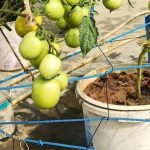Yes, tomato plants can be grown from a sliced tomato. With proper care and the right conditions, you can regrow tomato plants from the seeds contained in the fruit.
Tomato plants are known for their ability to regenerate and produce new growth from their seeds. Growing tomato plants from a sliced tomato may seem like a remarkable idea, but it is entirely possible. Tomatoes are known for their regenerative properties, allowing them to sprout new growth from their seeds.
If you are eager to try your hand at gardening or want to save money on buying seedlings, regrowing tomato plants from a sliced tomato can be a simple and rewarding project. By following the right steps and providing the necessary care, you can witness the transformation of a discarded tomato slice into a thriving tomato plant. We will explore the process of growing tomato plants from a sliced tomato and provide you with essential tips to ensure your success.
1. The Science Behind Tomato Regeneration
Have you ever wondered if it’s possible to grow tomato plants from a sliced tomato? The answer might surprise you. In this article, we will delve into the fascinating world of tomato regeneration and explore the science behind it. We’ll uncover the potential of a sliced tomato to grow into a new plant and examine the key factors that influence this process.
Understanding The Potential Of A Sliced Tomato To Grow Into A New Plant
It may seem unbelievable, but a sliced tomato has the remarkable ability to regenerate itself and give rise to a whole new tomato plant. This capacity lies within the tomato’s genetic makeup. Each tomato contains seeds and is packed with all the nutrients necessary to sustain the growth of a new plant. When a tomato is sliced, the seeds inside are exposed to the external environment, providing them with an opportunity to sprout and develop into seedlings.
Examining The Key Factors That Influence Tomato Regeneration
While the potential for tomato regeneration exists, several factors play a crucial role in determining whether a sliced tomato will actually grow into a thriving plant. Let’s take a closer look at these factors:
- Seed viability: The quality and viability of the tomato seeds are essential for successful regeneration. Fresh, healthy seeds have a higher chance of germinating and producing vigorous seedlings.
- Moisture: Adequate moisture is crucial for seed germination and subsequent plant growth. Seeds need a moist environment to activate the germination process and initiate root growth.
- Temperature: Tomatoes are warm-season plants and require a suitable temperature range for optimal growth. The ideal temperature for tomato seed germination is around 70-80 degrees Fahrenheit (21-27 degrees Celsius).
- Light: Although tomato seeds do not require light for germination, once the seedlings emerge, they need ample light to develop into sturdy plants. Positioning the seedlings in a location with sufficient sunlight or providing artificial grow lights can promote healthy growth.
- Soil quality: The soil in which tomato seeds are planted plays a vital role in their germination and subsequent growth. A well-draining soil rich in organic matter provides ideal conditions for root development and nutrient absorption.
- Proper care: Regular watering, appropriate fertilization, and protection from pests and diseases are crucial for the sustained growth of tomato plants. Providing the necessary care throughout the plant’s lifecycle enhances its chances of flourishing.
By understanding these key factors, you can increase the likelihood of successfully growing tomato plants from sliced tomatoes. Harnessing the power of tomato regeneration not only allows you to enjoy homegrown tomatoes but also adds a touch of sustainability to your gardening endeavors. So why not give it a try and witness the wonders of nature firsthand!
2. Choosing The Right Tomato For Regeneration
If you’re considering growing tomato plants from a sliced tomato, it’s essential to choose the right tomato variety for successful regeneration. Not all tomatoes are created equal when it comes to regrowing them from slices. In this section, we’ll explore some key factors to consider when selecting the best tomato varieties for successful regeneration.
Identifying The Best Tomato Varieties For Successful Regeneration
When determining the best tomato varieties for successful regeneration, it’s important to look for certain characteristics that lend themselves well to this process. Here are some factors to consider:
- Heirloom varieties: Heirloom tomatoes are known for their rich and diverse genetic heritage. They often produce seeds that are more likely to sprout and grow into healthy plants. Look for heirloom tomato varieties that suit your taste preferences.
- Indeterminate varieties: Indeterminate tomato varieties are known for their sprawling growth habit and continuous production of fruit throughout the season. These types of tomatoes tend to have a higher success rate when it comes to regeneration.
- Firm and juicy tomatoes: Choose tomatoes that are firm and juicy, as they indicate ripeness and freshness. Avoid selecting overripe or mushy tomatoes, as they may not have sufficient viable seeds for regeneration.
- Disease-resistant varieties: Growing tomatoes from sliced tomatoes requires healthy seeds that are less prone to diseases. Look for tomato varieties that are resistant to common diseases such as blight, wilt, or viruses.
Considering The Ripeness And Freshness Of The Tomato Slice
When using a sliced tomato to grow new plants, the ripeness and freshness of the tomato slice play a crucial role in the success of regeneration. Here are some key points to remember:
- Choose a fully ripe tomato: Opt for a tomato that is fully ripe but not overripe. A fully ripe tomato contains mature seeds that are more likely to germinate successfully.
- Freshness matters: Select a fresh tomato that was recently picked. Freshness ensures that the seeds are still viable and have a higher chance of sprouting.
- Avoid damaged or diseased slices: Damaged or diseased tomato slices may not yield healthy plants. It’s best to use slices that are free from any signs of rot or disease.
By considering the ripeness, freshness, and choosing tomato varieties with favorable characteristics, you’re setting yourself up for success when regrowing tomato plants from a sliced tomato. Now that you have all the essential information about choosing the right tomato for regeneration, let’s move on to the next step: preparing the tomato slice for regeneration.
3. Preparation Techniques For Tomato Regeneration
When it comes to regrowing tomato plants from a sliced tomato, the key to success lies in the preparation process. This is where the right techniques can make all the difference. In this section, we will explore different methods of preparing the tomato slice for regeneration and discuss the effectiveness of various techniques. By understanding these preparation techniques, you can increase the chances of successfully growing tomato plants from a sliced tomato.
Exploring Different Methods Of Preparing The Tomato Slice For Regeneration
Before we delve into the various techniques for preparing tomato slices, it is important to note that the success of regeneration depends on using ripe, healthy tomatoes. Once you have selected the perfect tomato, you can proceed with the following methods:
Air-drying the tomato slice
Air-drying is a popular method for preparing tomato slices for regeneration. It involves allowing the sliced tomato to dry naturally in a well-ventilated area. This process helps to reduce moisture content while allowing the tomato to retain essential nutrients. To air-dry the tomato slice:
- Cut the tomato into slices of uniform thickness.
- Place the slices on a clean, dry surface.
- Ensure that the slices are not touching each other.
- Leave the tomato slices to dry for approximately 24 hours or until they become leathery in texture.
Air-drying helps to prevent the growth of mold and other pathogens, increasing the chances of successful regeneration.
Using rooting hormone for tomato regeneration
Another technique that can enhance the success of tomato regeneration is the use of rooting hormone. Rooting hormone contains auxins, which stimulate root growth and increase the chances of successful plant regeneration. Here’s how to use rooting hormone for tomato regeneration:
- Prepare a rooting hormone solution following the manufacturer’s instructions.
- Dip the cut end of the tomato slice into the rooting hormone solution, ensuring it is fully coated.
- Place the treated tomato slice in a well-drained growing medium.
- Keep the growing medium moist but not waterlogged.
- Provide adequate sunlight or artificial light to promote growth.
Using rooting hormone can significantly improve the chances of successful regeneration by providing the necessary nutrients and encouraging root development.
Discussing The Effectiveness Of Various Techniques, Such As Air-drying Or Using Rooting Hormone
Both air-drying and using rooting hormone have proven to be effective techniques for preparing tomato slices for regeneration. Air-drying helps to remove excess moisture, thereby preventing mold growth and increasing the viability of the tomato slice. On the other hand, using rooting hormone provides the necessary hormonal stimulation for root development, enhancing the chances of successful regeneration.
It is important to note that the effectiveness of these techniques may vary depending on the tomato variety, environmental conditions, and individual plant characteristics. Experimenting with different techniques and observing the results can help determine the most suitable method for your tomato regeneration.
4. Creating The Ideal Growing Environment
Discover the secrets behind growing tomato plants from a sliced tomato, and create the perfect environment for them to thrive. Unleash your gardening skills with these effective tips.
When it comes to regenerating tomato plants from sliced tomatoes, creating the ideal growing environment is crucial for their successful growth. In this section, we will discuss how to provide optimal conditions and manage temperature, humidity, and lighting to ensure maximum growth potential.Providing Optimal Conditions For Successful Tomato Regeneration
To give your tomato plants the best chance of regenerating and growing successfully, it’s important to provide them with optimal growing conditions. Here are a few key factors to consider:1. Quality Soil: Start by choosing high-quality soil that is well-draining and rich in organic matter. Good quality soil provides the essential nutrients and proper moisture levels that tomato plants need to thrive.2. Adequate Drainage: Make sure your pots or containers have sufficient drainage holes to prevent waterlogging, which can lead to root rot. Proper drainage is essential to ensure oxygen reaches the roots and prevent water accumulation that could harm the plant.3. Ample Space: Tomato plants need space to grow. Whether you’re growing them indoors or outdoors, ensure there is enough space between plants to allow air circulation and prevent overcrowding. This helps minimize the risk of diseases and ensures each plant receives adequate nutrients and sunlight.Managing Temperature, Humidity, And Lighting For Maximum Growth Potential
Temperature, humidity, and lighting conditions play vital roles in the growth and development of tomato plants. Here are some tips to help you manage these factors effectively:1. Temperature Control: Tomato plants thrive in warm temperatures. Ideally, the temperature should be around 70-80°F (21-27°C) during the day and slightly cooler at night. Avoid exposing the plants to extreme temperature fluctuations, as this can cause stress and affect growth.2. Humidity Levels: Tomato plants prefer moderate humidity levels of around 50-70%. Too much humidity can create a favorable environment for fungal diseases, while low humidity can lead to excessive water loss through transpiration. Maintain a balanced humidity level by providing adequate ventilation and avoiding overcrowding.3. Proper Lighting: Tomato plants require plenty of sunlight to grow properly. Place your plants in a location that receives at least 6-8 hours of direct sunlight per day. If growing indoors, consider using grow lights that emit the full spectrum of light needed for plant growth. Position the lights at an appropriate distance from the plants to avoid heat stress.Conclusion
By providing optimal conditions and managing temperature, humidity, and lighting effectively, you can create an ideal growing environment for regenerating tomato plants. Remember to choose quality soil, ensure proper drainage, allow ample space for growth, control temperature and humidity, and provide sufficient sunlight or artificial lighting. These measures will help maximize the growth potential of your tomato plants and increase your chances of successful regeneration. Happy gardening!5. Care And Maintenance Of Regenerated Tomato Plants
Regenerated tomato plants require proper care and maintenance to ensure their growth and productivity. Growers can successfully grow tomato plants from a sliced tomato by following specific instructions, such as fermentation, planting, and regular watering and pruning.
Once you have successfully regenerated tomato plants from a sliced tomato, it is crucial to provide them with the right care and maintenance to ensure their healthy growth and fruitful yield. By offering proper nurturing, watering, fertilization, and pest control, you can help your regenerated tomato plants thrive. In this section, we will discuss some essential tips to help you take care of your newly grown tomato plants.
Offering Tips For Nurturing The Newly Grown Tomato Plant
When it comes to nurturing your regenerated tomato plants, consistency is key. Here are some tips to help you provide the best care:
- Provide adequate sunlight: Tomato plants require at least 6-8 hours of direct sunlight each day. Ensure that your regenerated plants are placed in a spot where they can receive abundant sunlight.
- Prune and support: As your tomato plants start to grow, make sure to prune the lateral branches and provide support to the main stem. This will help focus the plant’s energy on fruit production and promote its overall health.
- Monitor temperature: Tomatoes prefer temperatures between 70-80°F (21-27°C) during the day and around 60°F (15°C) at night. Keep an eye on weather fluctuations and protect your plants from extreme temperatures, especially during early stages.
- Practice crop rotation: If you have space available, consider rotating the location of your regenerated tomato plants each year. This helps prevent the buildup of soil-borne diseases and maintains soil fertility.
Discussing Watering, Fertilization, And Pest Control Practices For Healthy Growth
Proper watering, fertilization, and pest control are crucial to ensuring healthy and productive tomato plants. Here’s what you need to know:
Watering:
Tomato plants require consistent moisture, but overwatering can lead to root diseases and hinder growth. Keep the following watering practices in mind:
- Water deeply: Instead of frequent shallow watering, provide a deep watering once or twice a week. This encourages the roots to grow deeply, making the plants less prone to drought stress.
- Avoid wetting the foliage: Water the soil around the base of the plant, avoiding direct contact with leaves. Wet foliage can promote the development of fungal diseases.
- Use mulch: Mulching around the plants helps retain moisture in the soil, prevents weed growth, and maintains a more stable soil temperature.
Fertilization:
Supplying the proper nutrients to your tomato plants is essential for their healthy growth. Consider the following fertilization practices:
- Organic matter: Improve the soil’s fertility by incorporating organic matter, such as compost or well-rotted manure, before planting.
- Balanced fertilizers: Use a balanced fertilizer with equal proportions of nitrogen (N), phosphorus (P), and potassium (K). Follow the manufacturer’s instructions for application rates.
- Side-dressing: Apply a nitrogen-rich fertilizer, such as blood meal or fish emulsion, as a side-dressing during the growing season to provide an extra boost of nutrients.
Pest control:
To protect your regenerated tomato plants from common pests and diseases, follow these pest control practices:
- Inspect regularly: Regularly inspect your plants for signs of pests, such as aphids, tomato hornworms, or early blight. Early detection allows for prompt intervention.
- Handpick pests: If you spot any pests, remove them by hand or with a gentle spray of water. This can help reduce the population without the need for chemical pesticides.
- Use organic pest control: Consider using organic pest control methods, such as neem oil or insecticidal soaps, to manage pests while minimizing harm to beneficial insects.
By following these tips for nurturing and providing adequate care, as well as maintaining proper watering, fertilization, and pest control, you can ensure healthy growth and a bountiful harvest from your regenerated tomato plants.

Credit: extension.msstate.edu
Frequently Asked Questions On Can You Grow Tomato Plants From A Sliced Tomato
Can Tomato Plants Be Grown From Sliced Tomatoes?
Yes, it is possible to grow tomato plants from sliced tomatoes. The process involves placing the tomato slice on moist soil, covering it lightly, and providing proper care. With time, roots will develop, and a new tomato plant will grow.
However, success rates may vary depending on the tomato variety and growing conditions.
Conclusion
Growing tomato plants from a sliced tomato is a fascinating and cost-effective gardening experiment. Not only can it be a fun activity for families, but it also allows you to utilize the seeds from store-bought tomatoes. By following the proper steps, you can experience the joy of watching a new tomato plant emerge from what was once a discarded slice.
So why not give it a try and embark on your own tomato-growing journey? Happy gardening!

I am a graduate of Bangladesh Agricultural University, where I delved into various agricultural disciplines, equipping me with a profound understanding of agriculture. Beyond academics, I have hands-on experience in gardening and crop cultivation. My passion is to embrace sustainable farming and horticulture. With a BSc in Agriculture, I am dedicated to promoting environmentally conscious and efficient agrarian practices.
Bachelor of Science (BSc) in Agriculture (Hons.)
Master of Science. (Sustainable Agriculture & Food Security ) (MS)
Bangladesh Agricultural University
![Is Tomato Hornworms Poisonous? [Biological Fact] 1-28](https://broadpick.com/wp-content/uploads/2023/11/1-28-150x150.jpg)
![How To Separate Tomato Seedlings? [Interesting Facts Revealed] 1-36](https://broadpick.com/wp-content/uploads/2023/11/1-36-150x150.jpg)

